Assessment of Quality of Fresh Concrete Delivered at Varying Temperatures
Abstract
:1. Introduction
1.1. Main Issues Due to Hot Weather Concreting
1.2. Main Practices to Prevent and Mitigate Hot Weather Concreting Issues
2. Methodology and Data Collection
2.1. Methodology
- Design compressive strength (psi);
- Actual compressive strength f’c after testing of each sample; the average for each age is made afterwards (psi);
- Age of each sample testing (days);
- Fresh concrete temperature at the time of pouring (°F);
- Air temperature at the time of pouring (°F);
- Slump determined on site (in.);
- Water added on site (gal);
- Number of tested concrete cylinders;
- Diameters of tested concrete cylinders (in.).
2.2. Raw Data Collection
3. Analysis and Results
3.1. Compressive Strength
3.1.1. Relation between Compressive Strength and Air Temperature
3.1.2. Relation between Compressive Strength and Concrete Temperature
3.2. Ratio of Compressive Strength to Design Strength
3.2.1. The Relationship between Compressive Strength to Design Strength and Air Temperature
3.2.2. The Relationship between the Ratio of Compressive Strength to Design Strength and Concrete Temperature
3.3. Slump
3.3.1. The Relationship between Slump in the Field and Air Temperature
3.3.2. The Relationship between Slump in the Field and Concrete Temperature
3.4. Air versus Fresh Concrete Temperatures
4. Conclusions
- The air temperature in which the fresh concrete is poured has an effect on the compressive strength of the concrete. For a design compressive strength of 21 MPa (3000 psi), the highest compressive strength recorded for the specimens that were collected from the job site when the air temperature was around 18 °C (65 °F). For 31 MPa (4500 psi) design strength, the compressive strength fluctuated but did not show a significant trend.
- The ratio of the compressive strength over design strength fluctuated between 0.5 and 1.5 for the majority of the specimens when the local air temperature changed between 4 °C (40 °F) and 38 °C (100 °F).
- The ratio of the compressive strength to design strength was between 0.5 and 2.0 when the fresh concrete temperature was kept between 10° and 32 °C (50° and 90 °F).
- The slump value increased with the increase in the air temperature for the 21 MPa (3000 psi) design strength and fluctuated around 4 inch for 31 MPa (4500 psi) design strength.
- Fresh concrete’s temperature and air temperature are similar when they are in the range of 60 to 80 °F. Therefore, to limit the use of additional water or admixtures in, concrete should be poured when the air temperature during the pour is in the range of 16° and 27 °C (60° to 80 °F). This range implies a concrete temperature during pour between 60 to 80 °F, which is lower than the maximum allowable fresh concrete temperature specified in the ACI-305.1-06 “Specification for Hot Weather Concreting”.
Author Contributions
Funding
Data Availability Statement
Conflicts of Interest
References
- American Concrete Institute (ACI) Committee 305. Guide to Hot Weather Concreting, ACI 305R-10; American Concrete Institute: Farmington Hills, MI, USA, 2010. [Google Scholar]
- ASTM C1064/C1064M; Standard Test Method for Temperature of Freshly Mixed Hydraulic-Cement Concrete. ASTM International, American Society for Testing and Materials: West Conshohocken, PA, USA, 2017.
- Soroka, I.; Ravina, D. Hot weather concreting with admixtures. Cem. Concr. Compos. 1998, 20, 129–136. [Google Scholar] [CrossRef]
- Karakouzian, M.; Boehm, R.F.; Hudyma, N.; Harris, D.D. Effect of Reinforcement Temperature in Shrinkage Cracking of PC. Concr. Int. 1994, 16, 65–67. [Google Scholar]
- Ujhelyi, J.E.; Ibrahim, A.J. Hot weather concreting with hydraulic additives. Cem. Concr. Res. 1991, 21, 345–354. [Google Scholar] [CrossRef]
- Ahmadi, B.H. Initial and final setting time of concrete in hot weather. Mater. Struct. 2000, 33, 511–514. [Google Scholar] [CrossRef]
- Schindler, A.K.; Frank McCullough, B. Importance of Concrete Temperature Control During Concrete Pavement Construction in Hot Weather Conditions. Transp. Res. Rec. J. Transp. Res. Board 2002, 1813, 3–10. [Google Scholar] [CrossRef]
- American Concrete Institute (ACI) Committee 305. Hot Weather Conditioning, ACI 305R-99; American Concrete Institute: Farmington Hills, MI, USA, 1999. [Google Scholar]
- Almusallam, A.A. Effect of environmental conditions on the properties of fresh and hardened concrete. Cem. Concr. Compos. 2001, 23, 353–361. [Google Scholar] [CrossRef]
- FIP Commission on Practical Construction. Working Group on Concreting in Hot Weather, Fédération Internationale de la Précontrainte, & FIP Commission on Practical Construction. In Concrete Construction in Hot Weather; Thomas Telford Publishing: London, UK, 1986; Volume 54. [Google Scholar]
- Thomas, M.D.A. Optimizing the Use of Fly Ash in Concrete; Portland Cement Association: Skokie, IL, USA, 2007; Volume 5420. [Google Scholar]
- Malisch, W. Hot weather concreting tips. Concr. Constr. 1990, 35, 541–544. [Google Scholar]
- Gebremichael, N.N.; Karein, S.M.M.; Karakouzian, M.; Jadidi, K. Investigation of setting time and compressive strength of ready-mixed concrete blended with returned fresh concrete. Constr. Build. Mater. 2019, 197, 428–435. [Google Scholar] [CrossRef] [Green Version]
- Suh, Y.C.; McCullough, B.F. Factors Affecting Crack width of Continuously Reinforced Concrete Pavement. In Transportation Research Record; National Academy Press: Washington, DC, USA, 1994; Volume 1449. [Google Scholar]
- Al-Ani, S.H.; Al-Zaiwary, M.A. The effect of curing period and curing delay on concrete in hot weather. Mater. Struct. 1988, 21, 205–212. [Google Scholar] [CrossRef]
- Zeyad, A.M.; Johari MA, M.; Abutaleb, A.; Tayeh, B.A. The effect of steam curing regimes on the chloride resistance and pore size of high–strength green concrete. Constr. Build. Mater. 2021, 280, 122409. [Google Scholar] [CrossRef]
- Zeyad, A.M.; Johari MA, M.; Alharbi, Y.R.; Abadel, A.A.; Amran, Y.M.; Tayeh, B.A.; Abutaleb, A. Influence of steam curing regimes on the properties of ultrafine POFA-based high-strength green concrete. J. Build. Eng. 2021, 38, 102204. [Google Scholar] [CrossRef]
- Amin, M.; Zeyad, A.M.; Tayeh, B.A.; Agwa, I.S. Effects of Nano cotton stalk and palm leaf ashes on ultrahigh-performance concrete properties incorporating recycled concrete aggregates. Constr. Build. Mater. 2021, 302, 124196. [Google Scholar] [CrossRef]
- Jan, B. Benefits of slag and fly ash. Constr. Build. Mater. 1996, 10, 309–314. [Google Scholar]
- Nehdi, M.; Al-Martini, S. Coupled effects of high temperature, prolonged mixing time, and chemical admixtures on rheology of fresh concrete. ACI Mater. J. 2009, 106, 231. [Google Scholar]
- American Concrete Institute (ACI) Committee 305. Specification for Hot Weather Concreting, ACI 305.10-06; American Concrete Institute: Farmington Hills, MI, USA, 2006. [Google Scholar]
- Mindess, S.; Young, J.F.; Darwin, A. Concrete, 2nd ed.; Pearson Education Ltd.: London, UK, 2002. [Google Scholar]
- Yoo, D.Y.; Min, K.H.; Lee, J.H.; Yoon, Y.S. Shrinkage and cracking of restrained ultra-high-performance fiber-reinforced concrete slabs at early age. Constr. Build. Mater. 2014, 73, 357–365. [Google Scholar] [CrossRef]
- Behbahani, H.P.; Nematollahi, B.; Farasatpour, M. Steel Fiber Reinforced Concrete: A Review. In Proceedings of the International Conference on Structural Engineering Construction and Management, Kandy, Sri Lanka, 15–17 December 2011. [Google Scholar]
- Samarai, M.; Popovics, S.; Malhotra, V.M. Effects of High Temperatures on the Properties of Fresh and Hardened Concrete: A Bibliography (1915–1983). J. Proc. 1935, 30, 159–180. [Google Scholar]
- Ramakrishnan, V.; Perumalswamy, V. Effect of Hot Climate on Slump Loss and Setting Times for Superplasticized Concretes. In Transportation Research Board; US Army Corps of Engineers: Washington, DC, USA, 1983. [Google Scholar]
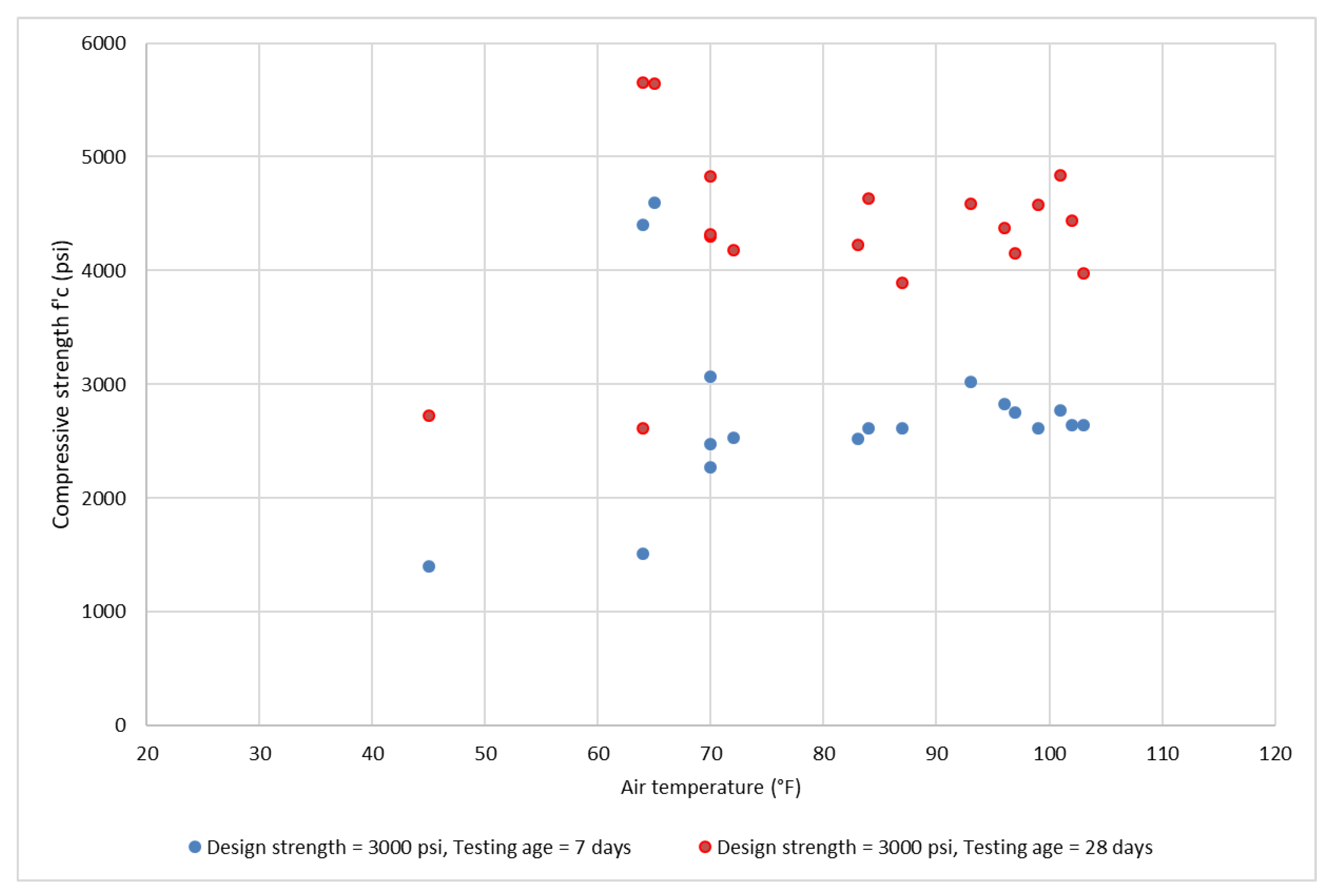
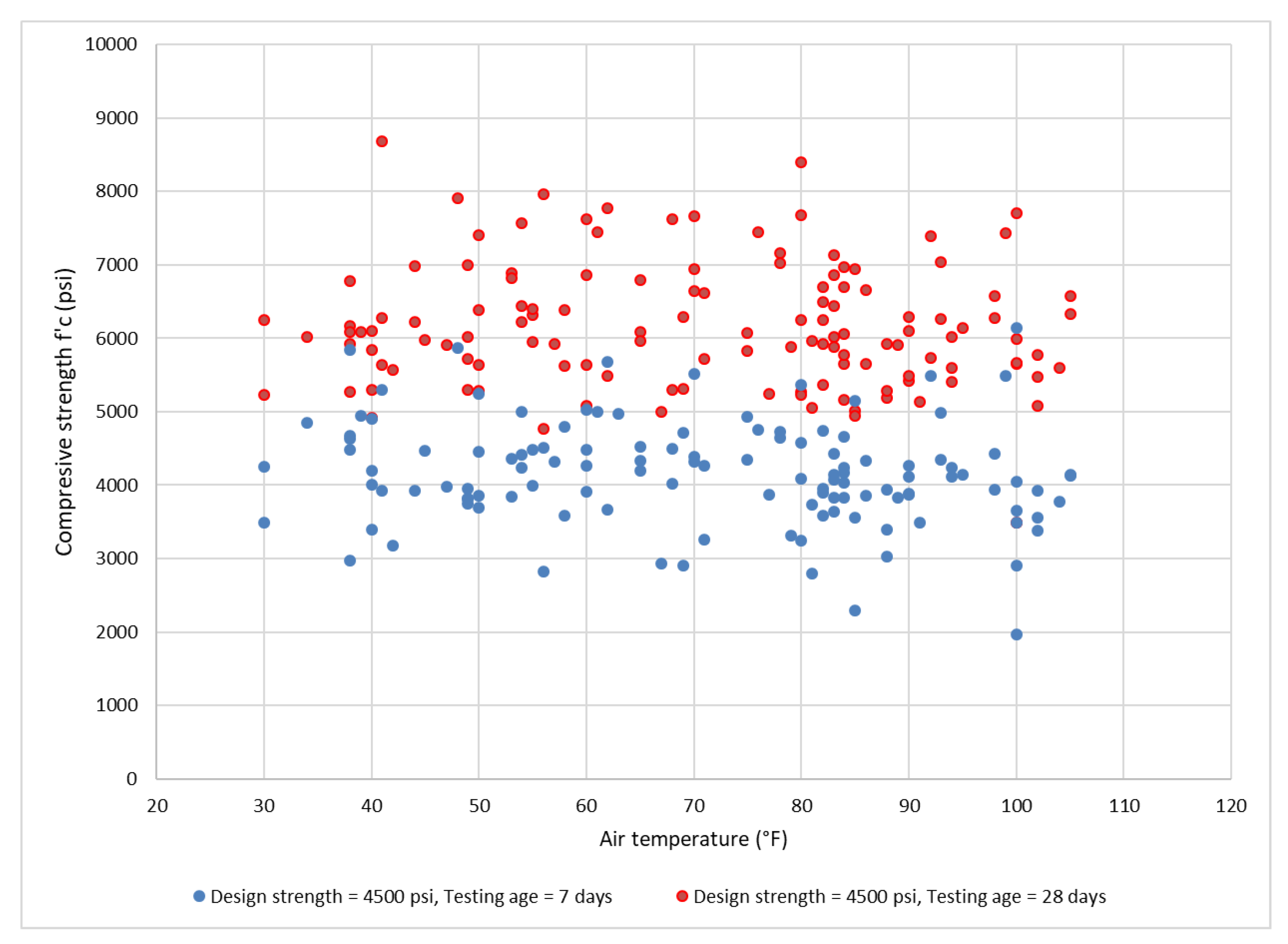
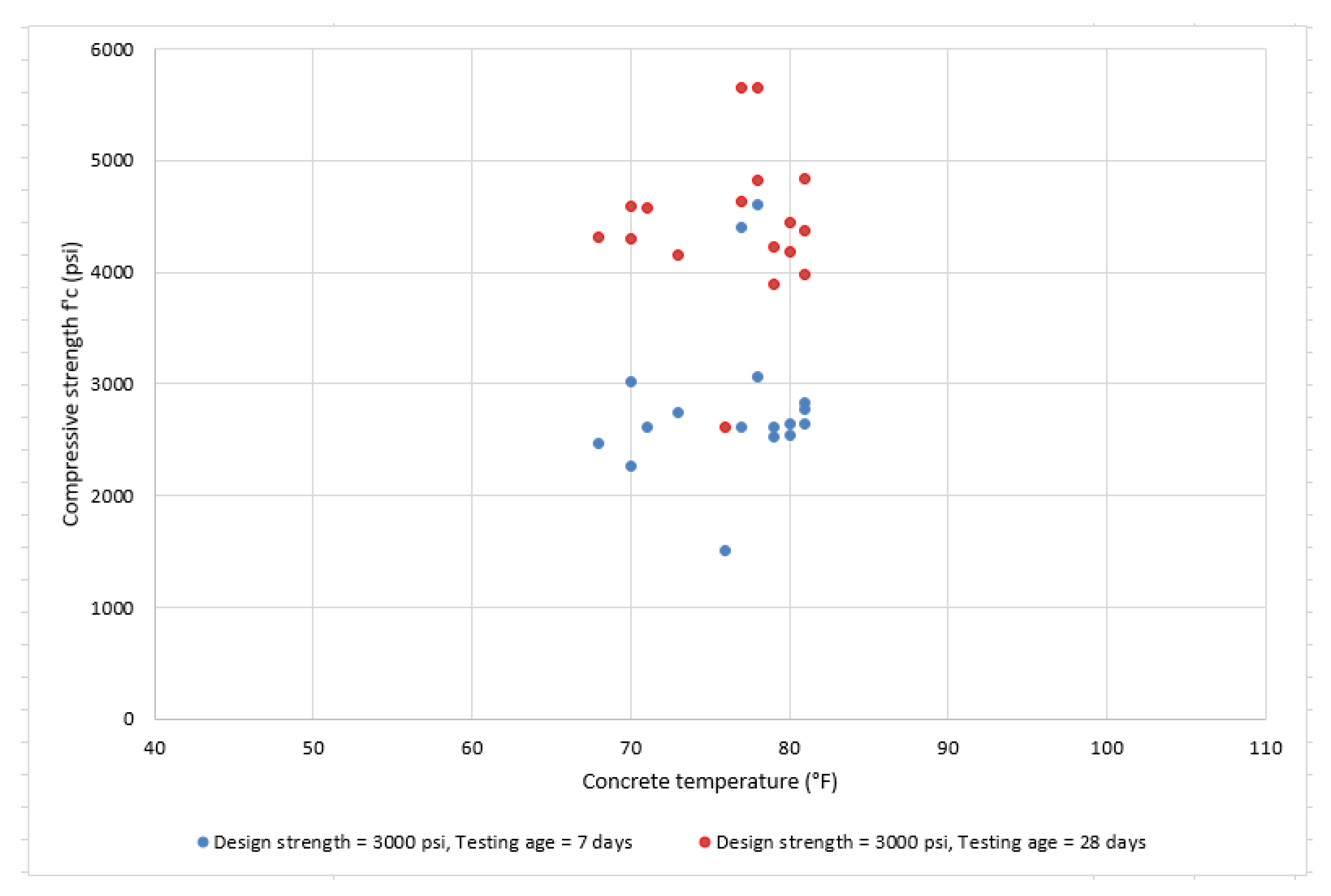


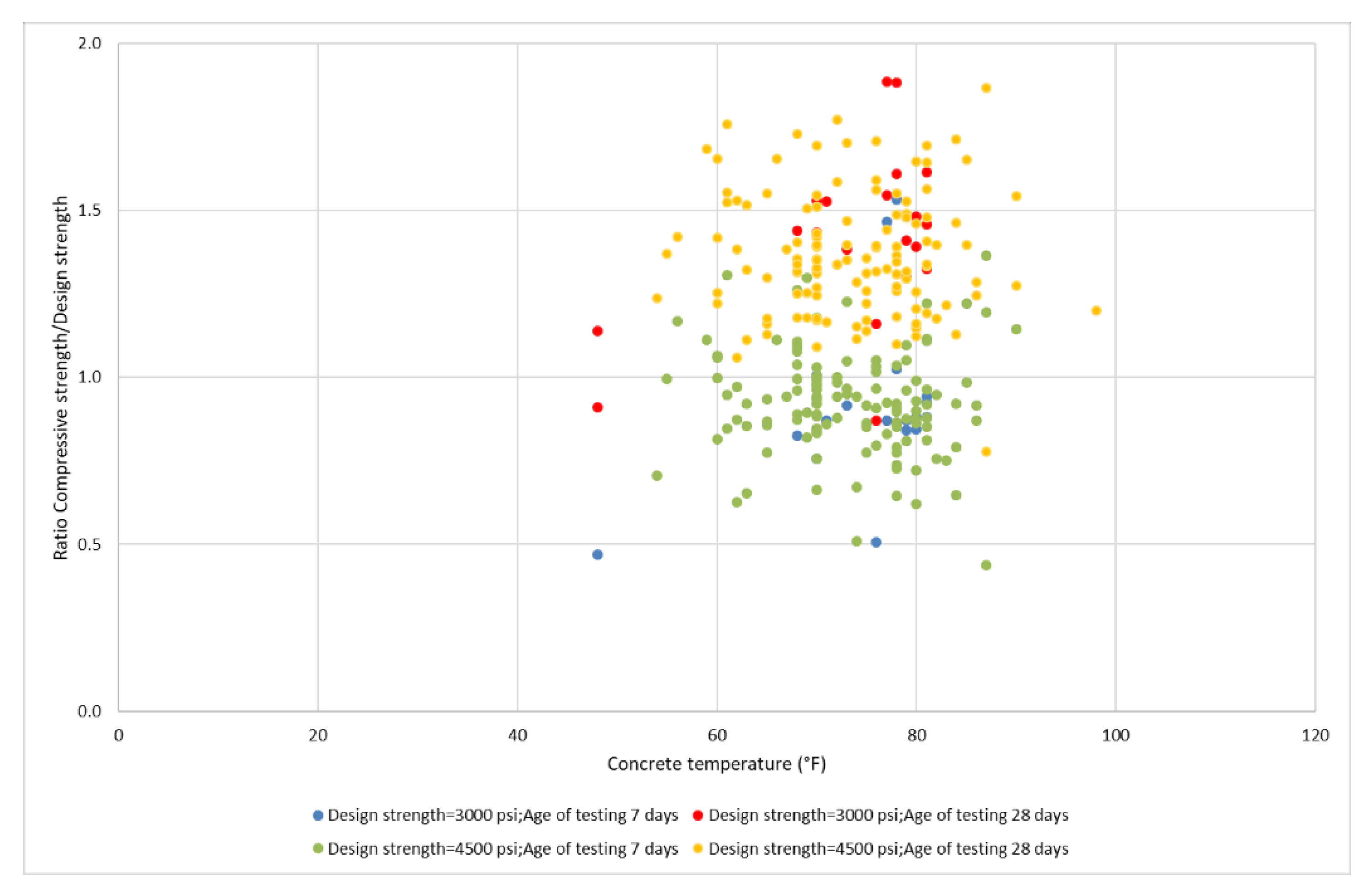
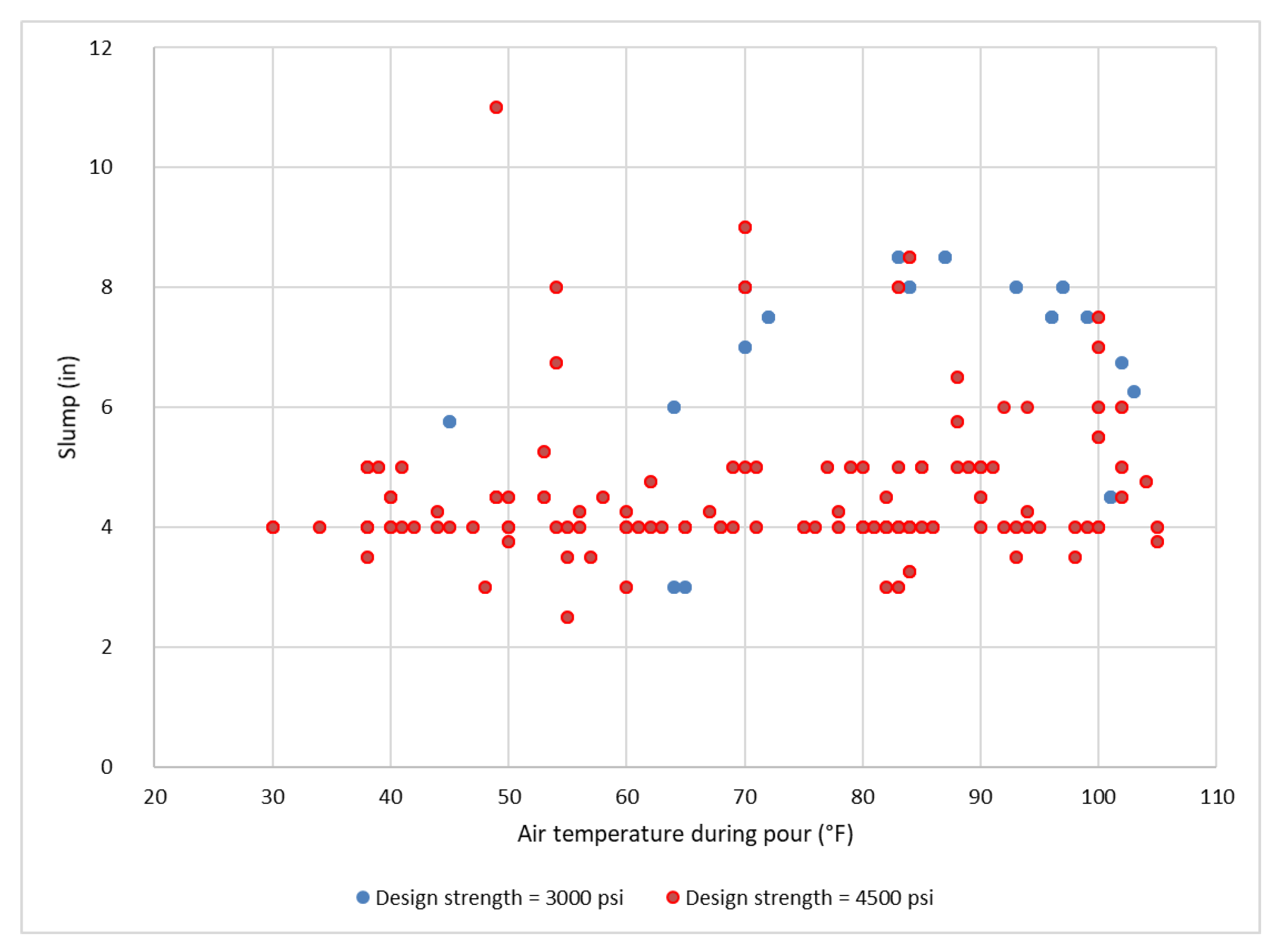
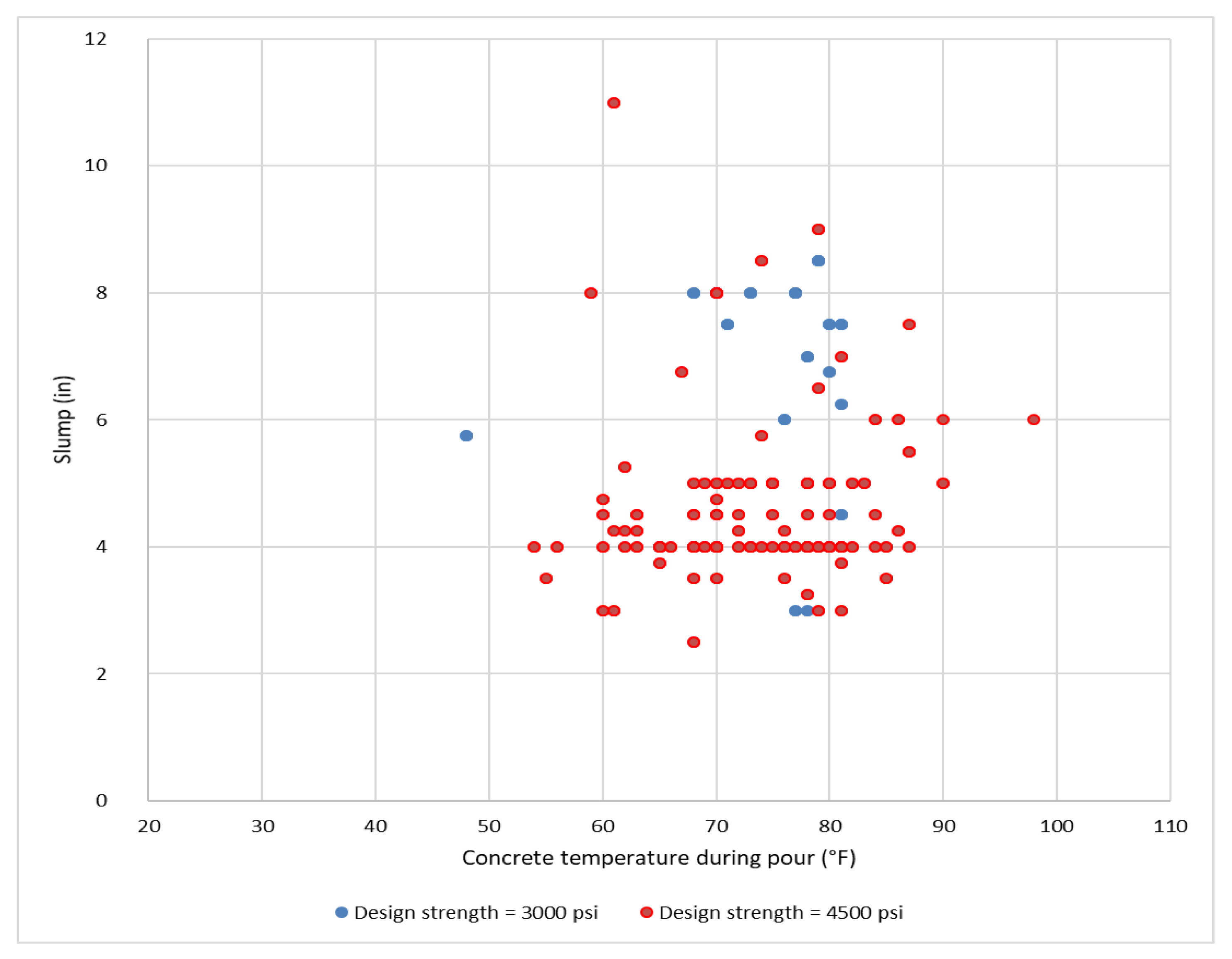
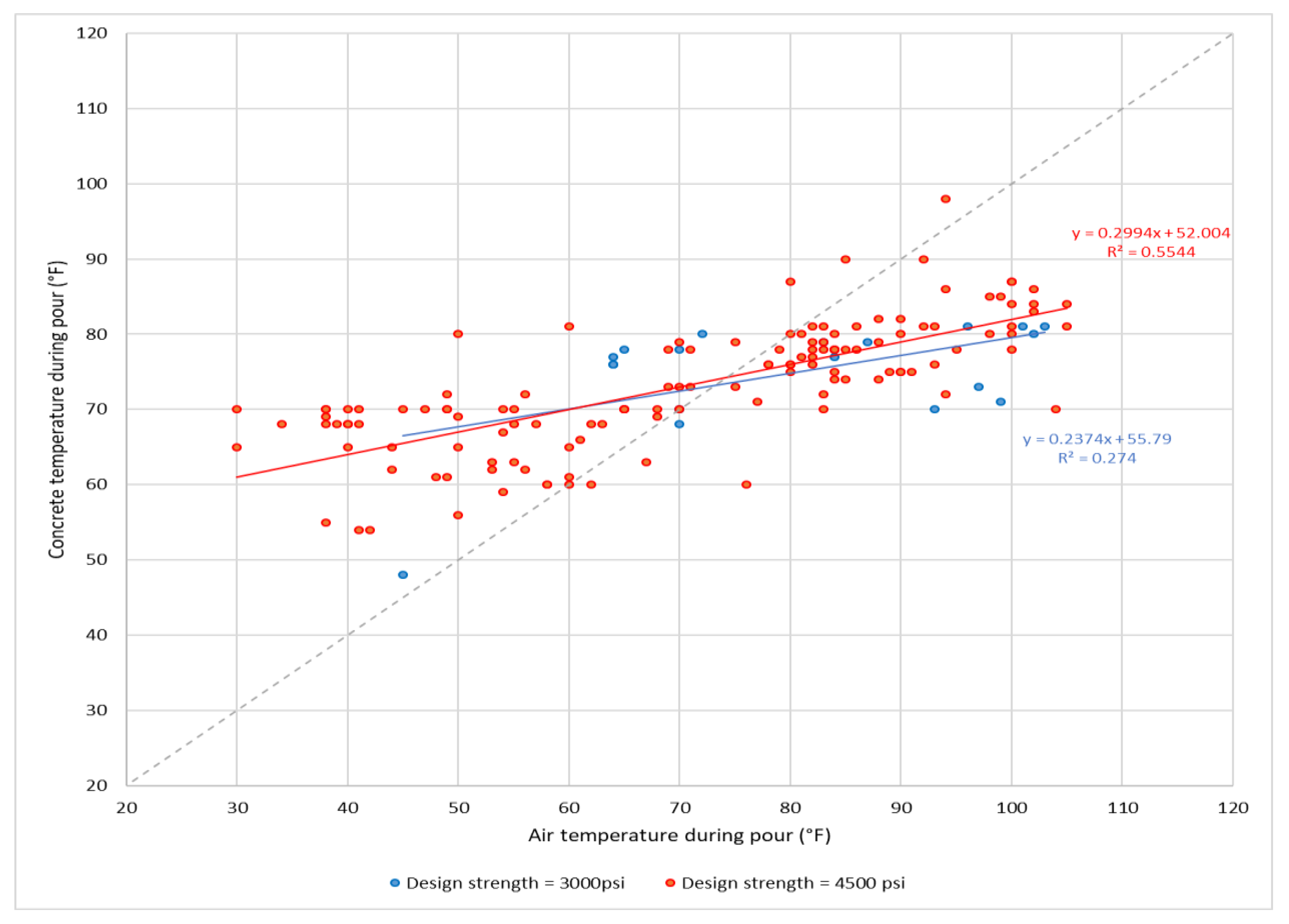
| Design Strength (psi) | Age of Testing (Days) | Number of Records |
|---|---|---|
| 3000 | 7 | 18 |
| 28 | 18 | |
| 4500 | 7 | 125 |
| 28 | 130 |
| Design f’c | Air Temperature | Concrete Temperature | Slump |
|---|---|---|---|
| (a) | (b) | (c) | (d) |
Publisher’s Note: MDPI stays neutral with regard to jurisdictional claims in published maps and institutional affiliations. |
© 2022 by the authors. Licensee MDPI, Basel, Switzerland. This article is an open access article distributed under the terms and conditions of the Creative Commons Attribution (CC BY) license (https://creativecommons.org/licenses/by/4.0/).
Share and Cite
Saidi, M.; Jadidi, K.; Karakouzian, M. Assessment of Quality of Fresh Concrete Delivered at Varying Temperatures. CivilEng 2022, 3, 135-146. https://doi.org/10.3390/civileng3010009
Saidi M, Jadidi K, Karakouzian M. Assessment of Quality of Fresh Concrete Delivered at Varying Temperatures. CivilEng. 2022; 3(1):135-146. https://doi.org/10.3390/civileng3010009
Chicago/Turabian StyleSaidi, Maroua, Kazem Jadidi, and Moses Karakouzian. 2022. "Assessment of Quality of Fresh Concrete Delivered at Varying Temperatures" CivilEng 3, no. 1: 135-146. https://doi.org/10.3390/civileng3010009
APA StyleSaidi, M., Jadidi, K., & Karakouzian, M. (2022). Assessment of Quality of Fresh Concrete Delivered at Varying Temperatures. CivilEng, 3(1), 135-146. https://doi.org/10.3390/civileng3010009








